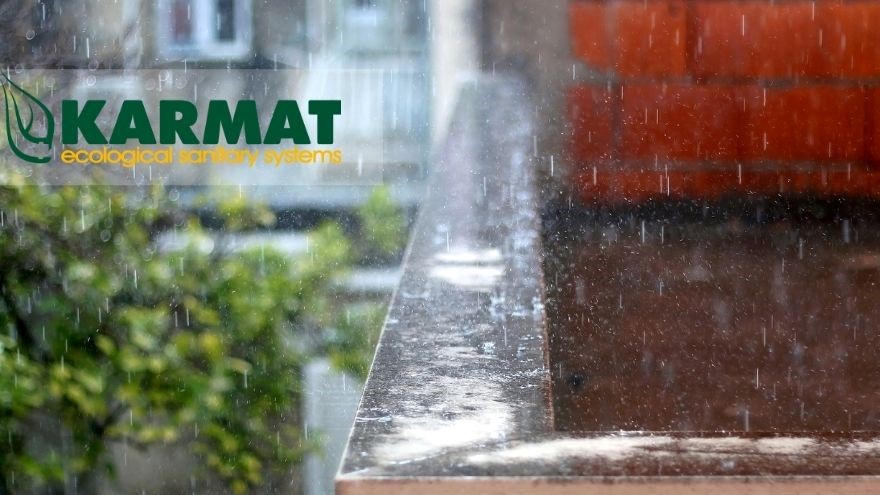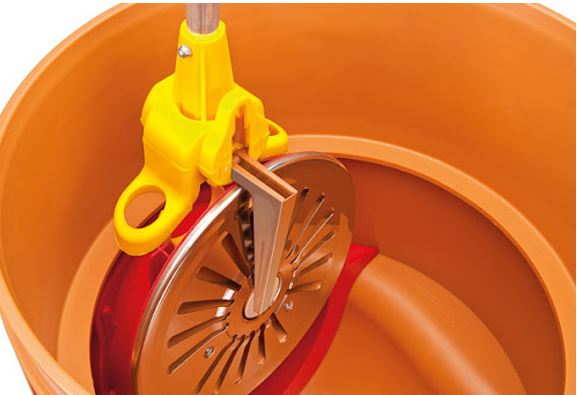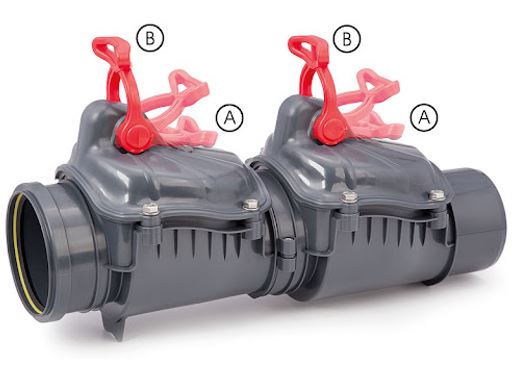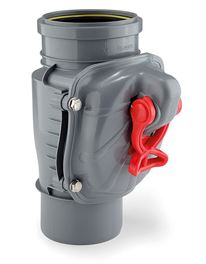In the event of very intense rainfall, the so-called reverse flow, as a result of which water and sewage accumulated in the sewage system flow back and flood the building. Not only utility rooms located in the basement or basement are at risk, but also those located at ground level. To prevent this, a storm gate should be installed, i.e. a type of non-return valve that guarantees only one direction of flow in the sewage system. What solutions are worth recommending to customers?

From this article you will learn:
- what are storm gate valves,
- how a storm gate valve works,
- how to properly install a storm gate valve,
- what storm gate valves to use.
What is a storm gate?
The storm gate valve is a quite simple structure, consisting of a flap hung loosely in the body and equipped with a gasket. Depending on the purpose, check valves may take the form of:
- single flap or double flap storm gate valves,
- storm gate valves for sewage systems with or without feces.
These are maintenance-free elements that do not require any control or adjustment of the flap position from the outside. Nevertheless, convenient access to them must be ensured during installation, as these devices should be regularly inspected. It may also be necessary to occasionally replace the seal or unblock the pipeline.
Despite their simple construction, all storm gate valves must meet the requirements of the EN-13564 standard (Anti-flood devices in buildings). Before installation, it is worth checking whether the device has the CE mark (compliance with European Union directives).
Check out the Karmat brand zone in the Onninen wholesaler
How does a storm gate valve work?

The simple design of the storm gate valve means an uncomplicated operating principle. The flap opens freely under the pressure of sewage flowing through the pipes. Therefore, it does not block their drainage in any way. It begins to perform its proper function only when, for example, due to heavy rainfall, reverse flow occurs. Then, the retreating sewage presses the valve flap against its body, blocking its way into the building.
The storm gate valve therefore protects the facility against flooding in a fully automatic manner. No intelligent system or manual operation is needed to control the device. These types of check valves come in various variants, but the principle of their operation remains unchanged.
How to install a non-return valve correctly?

Pipes with sockets and spigot ends are useful for installing a storm gate valve. The selected installation variant should depend on individual requirements, technical conditions of the building, but also on the available budget. Regardless of the location of the valve, it must be installed outside the frost zone.
The installation location of the gate valve and its diameter depend on how many objects the valve is to protect. External installation in one building usually requires a valve with a cross-section of 160 mm, because this is the size of the sewage pipes. The device is then mounted in an inspection well on the sewer. If the storm gate is to protect several objects, it should have a diameter of at least 200 mm and be placed in the collection sump.
The non-return valve can also be installed inside the building. In such a case, it will protect either the entire facility or one selected sanitary device. The first situation requires slightly more advanced methods, because the storm gate valve must be attached at the end of the main sewage pipe - on a horizontal or vertical pipe. It usually has a diameter of 110 mm. It's easier to install a valve that protects only one device - for example, a washbasin. In such a case, you need a flap with a cross-section of 50 mm, connecting directly to the siphon and the end of the sewage system.
Check out storm gate valves from the Karmat brand
Which storm gate valves should be used?
 Storm gate valves come in many variants, designed for installation in various places. We can distinguish 6 types of check valves, the most important of which are the following 3:
Storm gate valves come in many variants, designed for installation in various places. We can distinguish 6 types of check valves, the most important of which are the following 3:
- Type 1 - the basic type of gate valves used for installation in horizontal ducts. They are equipped with automatic and emergency closing mechanisms.
- Type 2 - storm gate valves intended for installation in horizontal ducts, with two automatic closing mechanisms and one emergency closing mechanism.
- Type 3 - a type of gate valves that are installed in horizontal ducts and have an automatic closing mechanism activated by external energy. In addition, they are also equipped with an emergency closing mechanism.
Exchange benefits in the new OnnTop loyalty platform!
Interestingly, in addition to storm gate valves installed in horizontal sewage pipes, there are also variants available on the market for vertical installation. They are useful when the vertical pipe is the only possible place to mount the device.
In addition to traditional check valves, it is also worth considering drainage storm gate valves. They are mounted directly on a corrugated pipe that discharges water accumulated in the drainage system around the building. Their additional function is to prevent rodents from entering the interior.
Storm gate valves may also differ in the number of non-return valves. Models equipped with two flaps will prove to be even more effective than their standard counterparts. Interestingly, these elements can not only respond to a change in the direction of sewage flow, but also rely on communication between the actuator and the probe placed in the flap. Then, when the pipe is filled to 80%, the flaps are automatically closed. It is worth remembering that the storm gate valve is also equipped with a manual lever. The ability to manually close the flaps is useful even when the building remains empty for a long time.
The choice of the appropriate type of gate valve and its additional functions depends on the specificity of each facility and the conditions in which the valve will be installed. The obligation to use such a device is specified in the Regulation of the Minister of Infrastructure of April 12, 2002 on the technical conditions to be met by buildings and their location. The following areas are particularly vulnerable to flooding due to backflowing sewage:
- rooms located under the maximum level of manholes,
- facilities equipped with septic tanks integrated with the internal installation,
- buildings in the flood zone.
Storm gate valves available at onninen.pl
The onninen.pl assortment includes a wide selection of anti-flooding devices that protect the building against reverse flow and unpleasant odors penetrating from the sewage system. A wide selection of check valves in the installation wholesaler makes it easy to adjust the storm gate valve to the technical conditions of the facility you are working on. The offer includes products from renowned brands Karmat and HL, such as:
- storm gate valve for horizontal installation,
- Karmat 50 storm gate valve for vertical installation, white ,
- storm gate valve with Karmat PP DN 50 elbow or pipe muff,
- storm gate valve with built-in rosette,
- storm gate valve with electronically controlled flap HL DN160 ,
- storm gate valve with manual locking and revision HL DN125 ,
- Karmat PP DN 110 double-flap storm gate valve .
Select storm gate valves according to the needs of your customers and ensure their safety and comfort of using the sewage system!
Do you have questions about the industry? Join the Świat Instalacji group!